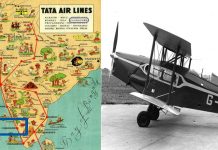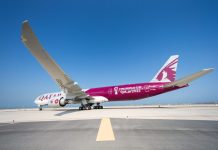In 1948, Air India International, then owned by Tata Sons Ltd., was granted status to operate international services from India as the designated flag carrier. The Government of India took a 49% stake in the company including an option to purchase a majority interest at their discretion and awarded a 10 year management contract to J.R.D. Tata to run the airline.
The morning of 18 April 1971 represented the proudest moment in Air India’s history as the first Boeing 747-237B registered VT-EBD touched down at Bombay, catapulting the airline into a select group of international carriers to operate this “747th wonder of the world”. To commemorate this occasion, a new livery was introduced in a “Your Palace In The Sky” theme featuring Rajasthani arches individually painted around every window on the main deck.
Air India operated a total of 11 B747-237Bs, including 4 that remain with the airline today.
B747-237B
VT-EBD : Emperor Ashoka
VT-EBE : (Emperor) Shahjehan
VT-EBN : (Emperor) Rajendra Chola
VT-EBO : (Emperor) Vikramaditya
VT-EDU : (Emperor) Akbar
VT-EFJ : (Emperor) Chandragupta
VT-EFO : (Emperor) Kanishka
VT-EFU : Krishna Deva Raya
VT-EGA : Samudragupta
VT-EGB : Mahendra Verman
VT-EGC : Harsha Vardhan
On New Years Day of 1978, “Emperor Ashoka”, the beloved flagship of the fleet and pride of India was lost on takeoff from Bombay en route to Dubai. The crash was attributed to the failure of the Attitude Director Indicator on the instrument panel and the inability of Capt. Kukar to respond appropriately. All 23 crew and 190 passengers on board were killed.
In August 1979, the Janata Party government of Charan Singh made one of their first acts in power an order to strike the word “Emperor” from the names of Air India’s aircraft. A simultaneous order was given to replace English with Hindi titles on the port surface of the vertical fin. Prior to this, both surfaces of the vertical fin had English titles while the fuselage had Hindi titles on the starboard side and English on the port. “Krishna Deva Raya” was the first aircraft delivered under this new convention, while the other aircraft were repainted by the end of 1981.
24 June 1985 was another dark day in Air India’s history as (Emperor) “Kanishka” fell victim to a terrorist bombing while operating a flight from Canada to London. All 22 crew and 327 passengers aboard were killed.
In order to replace “Kanishka”, a decision was made to acquire a single Boeing 747-212B that had previously been owned by Singapore Airlines. Accordingly, VT-ENQ was delivered to Air India in May 1987. Keeping with the tradition of naming Boeing 747s after Indian kings, it was proposed to name this aircraft as “Shivaji” after the 16th century king of the Marathas. Unfortunately the Shiv Sena, a local Bombay political party that considered Shivaji as their spiritual leader, took offense to this proposal. They believed that it was an insult to their leader that a previously owned aircraft would be named in his honor, whereas other leaders had brand new aircraft as their namesake. In the end, a compromise was reached to name the aircraft “Himalaya” after the mountain range in Northern India.
B747-212B
VT-ENQ : Himalaya
In October 1988, Air India took delivery of a pair of a brand new aircraft type, the Boeing 747-337M Combi. The first of these airframes was finally named “Shivaji” and it was proposed to name the second one as “Aurangzeb” after the Mughal king of the same period. Again the Shiv Sena raised objection, primarily because they felt it an affront to Shivaji that a Muslim king would have had the same type of aircraft named after him. Accordingly, the second aircraft was named “Narasimha Varman” after the Hindu Pallava king instead. It was also decided that the convention of naming Boeing 747s after kings would be abandoned.
B747-337M
VT-EPW : Shivaji
VT-EPX : Narasimha Varman
In August 1993, Air India took delivery of the new flagship of its fleet when the first Boeing 747-437 registered VT-ESM made history by operating the first ever nonstop flight between New York and Delhi. The Boeing 747-400s were to be named after places of architectural or tourist interest in India.
B747-437
VT-ESM : Konark
VT-ESN : Tanjore
VT-ESO : Khajuraho
VT-ESP : Ajanta
VT-EVA : Agra
VT-EVB : Velhagoa
In November 2002, Air India acquired the first Boeing 747-4B5 on lease from Korean Air. In the interest of maintaining the convention of naming the cities after places of architectural or tourist interest, it was proposed to name the first leased aircraft registered VT-EVJ as “Prayag” after the ancient holy city.
Unfortunately, due to protests by an ultra-nationalist Hindu group that took offense to a previously owned aircraft being christened with the name of its holy city, the aircraft was finally named as “Fatehpur Sikri” after the world heritage site of sandstone buildings.
B747-4B5
VT-EVJ : (Prayag) Fatehpur Sikri
VT-AIC : Sanchi
VT-AID : Kaziranga
B747-412
VT-AIE : Mamallapuram.
And that is the history of every aircraft operated by Air India in the last half century and more.
Source – Airliners.net.


















